Tsitsi Dangarembga pictured after receiving bail following her arrest in Harare on July 31.
(Photo: Jekesai Njikizana)
At the end of July, the world saw Tsitsi Dangarembga “walking the talk” on the streets of Harare, carrying a placard, joining the protests over media repression and government corruption. In what seemed to be a matter of hours, the police were dispatched to clear the streets and the author was seen escorted into the back of a police truck. She live-tweeted her arrest and was shortly released on bail on 1 August 2020.
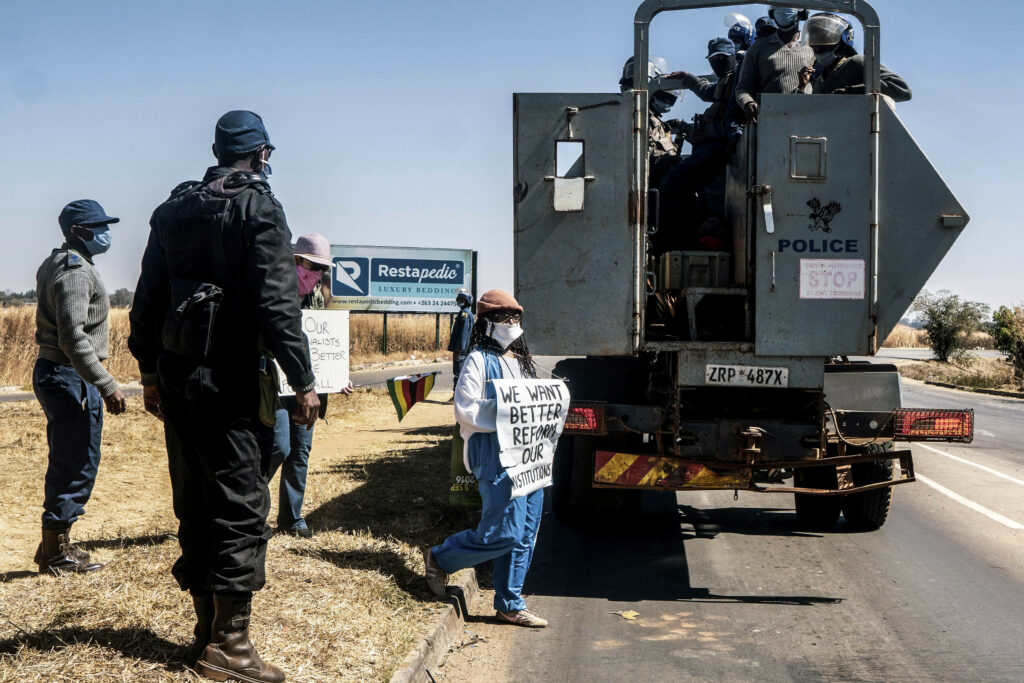 Zimbabwean novelist Tsitsi Dangarembga (C) and a colleague Julie Barnes hold placards as they are arrested during an anti-corruption protest march along Borrowdale road, on July 31, 2020 in Harare. (Photo by Zinyange Autony/AFP)
Zimbabwean novelist Tsitsi Dangarembga (C) and a colleague Julie Barnes hold placards as they are arrested during an anti-corruption protest march along Borrowdale road, on July 31, 2020 in Harare. (Photo by Zinyange Autony/AFP)
Although the charges of (intending to incite violence) remain against Dangarembga, her literary work continues to clear new paths. In This Mournable Body, the third and final book in the trilogy that began with Nervous Conditions (1988), the protagonist, Tambudzai Sigauke, is now an adult in her late thirties. The anti-climax and the changing-same of Southern Rhodesia’s transition to post-independent Zimbabwe has left Tambudzai residing in a dilapidated youth hostel in Harare. She is over-age and succumbing to self-loathing.
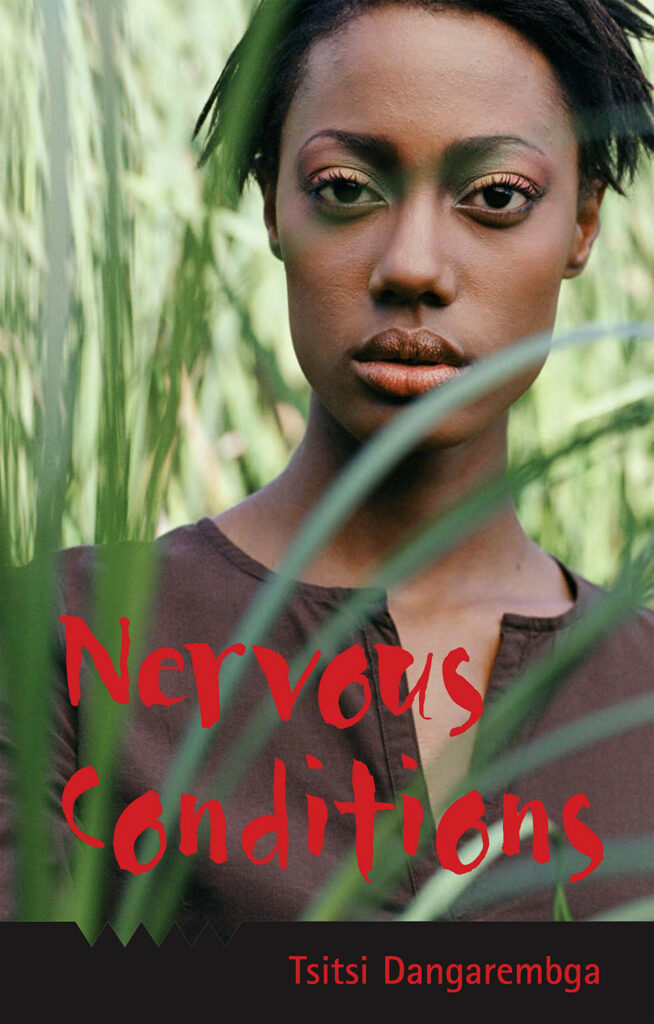 An African feminist classic, Nervous Conditions, was first published by the Women’s Press in the United Kingdom in 1988
An African feminist classic, Nervous Conditions, was first published by the Women’s Press in the United Kingdom in 1988In This Mournable Body, Tambudzai has become a shadow of the endearing pre-adolescent we first met in Nervous Conditions. She is an embodied reflection of a rapidly decaying and ruthless environment. By nurturing a repertoire of participating in the violation of Black women and girls within her proximity, she develops a wrought-out animus towards her own kind. Although there is an overwhelming urge to recoil and righteously separate ourselves from the budding sadomasochist that Tambudzai is becoming, by narrating the story in the second person; Dangarembga empathetically pulls us back into the deep end of Tambu’s fraying psyche.
Across the Tambudzai trilogy, it is through Tambuzai’s perceptive eyes that we become acquainted with a constellation of her female relatives. They, like her, reckon with the psychological afflictions that come with existing in a world that entraps them through the competing violences of patriarchy, antiblackness and poverty.
The Mail & Guardian interviewed Dangarembga about This Mournable Body, the book that earned her a place on the Booker prize shortlist. The Booker prize winner for 2020 will be announced on 19 November.
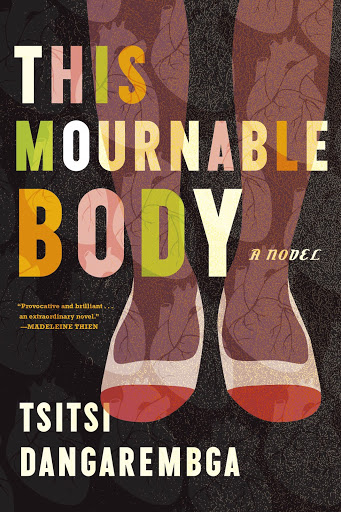 This Mournable Body, which completes the Tambudzai trilogy, has been shortlisted for the Booker Prize
This Mournable Body, which completes the Tambudzai trilogy, has been shortlisted for the Booker Prize
What is it about Teju Cole’s use of the term “unmournable bodies” that resonated with you and the vision you had for the last book in the trilogy?
It was the question he posed about which bodies we deem as mournable and which bodies we deem as unmournable. So he was asking what values are we putting on different kinds of bodies, and why? And he asked that question in an essay in the aftermath of the Garissa massacre in Northern Kenya, where very many dozens of Kenyan students were murdered at university and there was not a great outcry in the world about that massacre. Whereas before that, there was the Charlie Hebdo massacre in France and there had been almost a planet-wide outcry of grief and outrage, with people taking on the tag “Je suis Charlie”. Nobody said, “I am a student of Garissa”.
It was important for me to ask that question as well, to say, “Look, this is an average woman in Zimbabwe today and there are many people like Tambudzai Sigauke. Are we mourning them? Are we mourning the terrible fate that befalls them? Even if some of it is due to their own behaviour, are we mourning the fact that there are no resources that can help people like that with whatever crises they have in their lives?”
It was also a question to African people to ask ourselves: Are we mourning ourselves and each other and this state we are in? What is our response? Is it a Tambudzai response of just wanting to scramble out of it at any cost?
You shift from first-person narration in Nervous Conditions and The Book of Not to second-person narration in This Mournable Body. What psychological aspects and insight does this type of narration open up to readers?
Initially, I had wanted to continue This Mournable Body in the first person, but as I wrote the novel and explored Tambudzai’s world and inner state more, I realised what a dark and depressing world I was creating and moving in, both externally and internally.
So the question for me then was: Will I as the writer be able to do justice to such a disturbing world in the first person? And will the reader want to be immersed in such a world? I already felt that I couldn’t do that world justice, especially since it reflects so much of what is happening in Zimbabwe today, although it is set about 20 years earlier.
By the time I was completing the manuscript a few years ago, I felt very close to what was going on, so I needed a way to establish distance for myself as a writer, and also for the reader. I needed something that was not as distant as the third person, given that the other two [novels] were in the first person.
That left me with the second person. I had to try it out. I had no option and when I did, it worked very well because it put me in that situation that people often use when speaking to another person about something very close and perhaps distressing. One often says “you”, meaning myself. And so I felt that that was the kind of voice coming through, so I went with it.
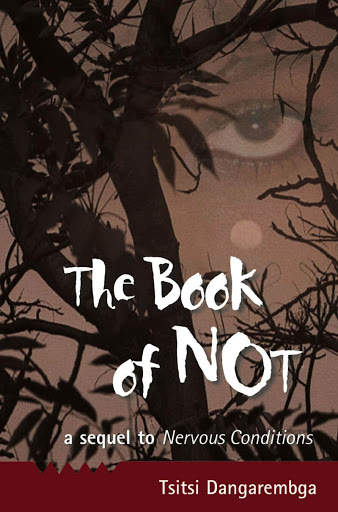 The Book of Not tracks Tambudzai’s quest to redefine the personal and political forces that ensnare her
The Book of Not tracks Tambudzai’s quest to redefine the personal and political forces that ensnare her
One of the most striking aspects about the trilogy is your stunning ability to depict everyday acts of violence in both mundane and spectacular forms and you do this in a familiar and relatable way even for readers outside of Zimbabwe. How does your environment in Zimbabwe inform these aspects of the novel?
That is a very significant question because one of the things that, maybe up until now, Zimbabweans prided themselves on, is being peace-loving people. But my experience of Zimbabwe is that it is not quite as peace-loving as we claim. From the time I was a child, I witnessed things that seemed to me to be acts of violence and they were taken as a given in the society.
I wanted to point out that all these little acts of violence, which we feel are ordinary and normal and nobody has to worry about — they add up to something. They add up to a society that, at the least, distances itself and does not engage to reduce acts of violence. I think we can see the culmination of that now in the way that Zimbabwe is going and so it really is a plea for us to be more engaged with small acts of violence.
I think there is something more to be said about how small acts of violence accumulate and combust around and through the protagonist Tambudzai. This happens along the modes of patriarchy, class and race, mainly antiblackness. Could you speak on this aspect?
When we first meet Tambudzai as a young girl in Nervous Conditions, she has that violent outburst towards her brother and one can think that it is provoked and so, perhaps, excusable. If you remember, in Nervous Conditions there wasn’t much of a reaction to that: it was just one of the fights that children have and that was it.
When she is under these very stressful conditions in the This Mournable Body we see that very same violence erupting out of her, first of all more or less passively when she goes along with the crowd [that attacks and strips Gertrude at the market square], then later on when she beats the student.
The way she is able to tolerate that within herself and act as though everything is alright — I’m saying that if we continue to do this, those acts of violence that we don’t really engage are going to come back to haunt us.
Would you frame the trilogy, and more importantly This Mournable Body, as a psychological portrait of Zimbabwe?
Through my writing, I have not found a boundary between the individual and society. I think the only way the individual affects society in a positive way is if we make people more conscious of that link. So definitely, I would say that my characters do represent the societies in which they are in and that is not something I do intentionally, but by creating characters that are meaningful for me.
What is the significance of the scenes with the laughing hyenas that have conversations with Tambudzai and the ants that crawl on her?
With the ants, I wanted to have a sensory image of when you get the shivers; of something crawling over your skin. I remember when I was very young, when I was about three or so, somebody dug up an ants’ nest and I remember they were really the tiny black ones. There were just like millions of them. After that I really got quite ill and I had to go home and take a bath every half hour because I could feel the ants all over my body until the next day. Ants are also a sign of decay, when something has died; apart from flies, you also have ants coming to feast on it.
The hyena is also a symbol of death and decay because it lurks to take the carrion, without actually doing a lot of the killing itself. There is a thing behind you that you know is coming. It is as though Tambudzai is aware of the decay within her. The most bloodcurdling sound I have ever heard was a hyena laughing at night. So again, I took that sound to elicit that sensory shock and the idea of something lurking. I link it to that act of violence to show that you cannot be violent towards somebody else without that violence doing equal damage to you.
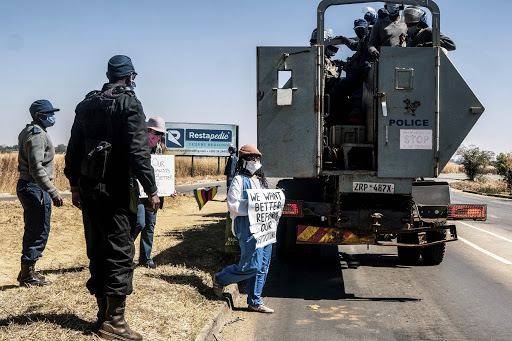 Tsitsi Dangarembga being arrested with colleague Julie Barnes in July during a protest against media repression and government corruption (Photo: Ziyange Auntony/AFP)
Tsitsi Dangarembga being arrested with colleague Julie Barnes in July during a protest against media repression and government corruption (Photo: Ziyange Auntony/AFP)
What becomes increasingly apparent is Tambudzai’s brutal relationships with Black women around her, from her difficult relationship with her mother, to her pleasure in the misogynist mob attack of Gertrude. Near the end, she plots to showcase her female relatives in a ‘Village Eco transit’, which resembles something of a human zoo set up. It is as though on her path to success she is becoming estranged from herself.
As you have mentioned before, Tambudzai is in a condition of alienation from herself. From her earliest days her mother is everything that she wishes to not be. She hasn’t seen those Black women who can act as a role model to her; the successful, satisfied Black woman. And when I say successful, I don’t mean just materially, but just as a human being who can find her place in the world in a dignified manner and function well in it.
Tambudzai did not have that. You know we hear about the Black mothers who are so strong and can hold things together — and they do exist — but they are not everybody’s story. I think that the people who don’t have those strong Black mothers who hold everything together are actually quite intimidated by that narrative, because are they allowed to say that not all Black mothers are superwomen? Some of them are just women and many of them find that their circumstances get them down, you know, which is perfectly legitimate.
So there is no place of release for all this negative energy that Tambudzai has and her only thought is, “I must get away from it, I must get away from it …” But at the same time, she means getting away from herself. She has no mental schema for how she can integrate her desires and where she is coming from, where she began and where she is going.
She is in a dilemma: in my mind she is even in a worse dilemma than Nyasha. At least Nyasha had some certainties about what the issues were. Tambudzai’s alienation from Black womanhood is a dysfunctional reaction to what is around her in society and she hasn’t been fortunate enough to find those nurturing spaces to help her heal that type of dysfunction.
I think that there could be a number of women who are in a similar situation. Things are getting better, of course, with the internet there is more consciousness and people have more access to resources that are helpful. Consciousness is changing. But for Tambudzai that had not happened.
 Tsitsi Dangarembga says the filmmaking process in Africa has to be wrestled out of the development paradigm, which always perceives Africans as lacking. (Photo: Hannah Mentz)
Tsitsi Dangarembga says the filmmaking process in Africa has to be wrestled out of the development paradigm, which always perceives Africans as lacking. (Photo: Hannah Mentz)
You have a background in filmmaking: your film Neria is the highest grossing film in Zimbabwe; in fact, you are the founder of the International Images Film Festival for Women. What complexities have you encountered in the visual narration of Black women’s stories?
The complexities and the challenges are enormous. You mention Neria as having been the highest grossing film when it was released. Yes, it was. I was commissioned by an American company to make that: an American man and his wife. I do not know how many feature films they made together. I went on to make another one with them, Everyone’s Child, and then consulted on a couple more.
I have not been in a position to make a single feature film of my own. Those films were made within the development paradigm, and so they depict African people and women as being in situations of lack and needing to grow in consciousness to go to the next stage of their development, which is all right, except that in my opinion there is an exclusion of the aspirational.
I find that this cuts across gender in narrating Black people on the continent and especially in my part of the continent where we are trapped in this development paradigm. So we constantly have an image of ourselves as lacking and that is fed back to ourselves.
Our aspirations are not deemed worthy of narration, so how are we even to know that it is all right to have aspirations, to go out and work to manifest them and to know what responsibility comes with that success unless we narrate these things.
So, for me, I have found that this developmental view on the continent, especially in the area of film, which is capital intensive, has really worked to keep us in a mental space that is defined by lack, and I think it is something we have to break out of.
This is why a film like The Boy Who Harnessed the Wind just does so much, because we normally do not see those stories. Capital is itself a system that has certain objectives and so we cannot say that this is accidental or random.
If it were accidental or random, it wouldn’t take somebody like me, with all the energy that I have and the narrative, more than two decades and I still haven’t made my first feature film — no matter how I have tried to do it, so the structural issues are huge. They come from the way that society is structured with respect to Blackness and with respect to Black womanhood.
Again, we are at a moment of change: people are beginning to understand that what happens in Africa is actually going to happen in the rest of the world, because what happens in Africa is not necessarily determined by Africans, it is determined by the global system. So it means that if it is manifested in Africa, there is potential for that anywhere in the global system, and we are beginning to see this happen.
Dr Zamansele Nsele is an art historian. She teaches cultural studies in the English department at the University of Johannesburg.
This article was produced as part of a partnership between the Mail and Guardian and the Goethe-Institut focusing on various aspects of innovation